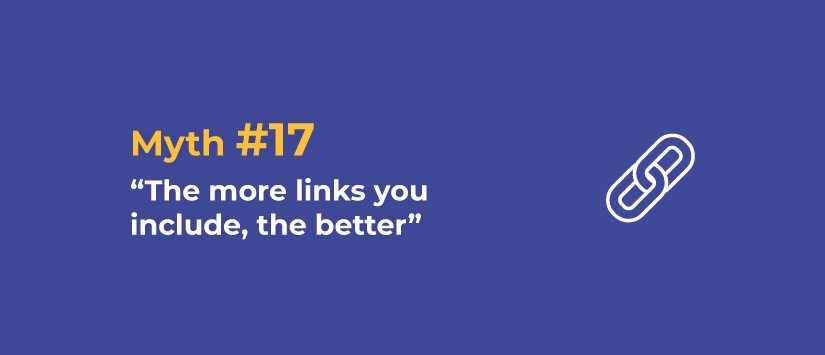Category: Email Marketing

Links are a metric of success in email marketing because it is what drives the user to visit a landing page or buy a product. Getting them out of the email inbox is a valid objective in campaigns that seek this conversion and that is why some people believe the myth that it is a good practice to include many links. In reality, doing so is a mistake that can have the opposite effect and result in fewer people being able to access the mailing.
Including many links in an email with little text is a common practice of spammers, so even if the message is sent in good faith, it may be considered as such and not pass the filter. Then, deliverability will drop for that and future mailings because, if the practice is repeated, the email manager will end up blocking the sender.
Obviously, it is not recommended to link to disreputable pages or executable files that may be suspicious, but this can happen even when it is your own page or some that at first glance do not seem malicious. It is therefore important that the destination page is secure (https) and that you check the links to ensure that they are not broken, especially if you are careless when typing them.
On the other hand, the common practice in other environments of shortening links to obtain click-through statistics is unnecessary because professional email marketing platforms already count them and can also affect deliverability. The reason is again that it is such a common practice by spammers that it can cause mailers to block emails with shortened links.
If you follow the rule of 1 and make a campaign for a single purpose, one link is enough. The user will not have to decide and you will not have to justify each link. In this way, you focus attention on one action and do not distract the user from what you want them to do. If all the communication revolves around getting that click, there will be less hesitation on their part and they will act more convinced.
A link can be repeated in the same message if it is placed in different places. For example: a button can be used at the beginning and another one at the end, i.e. for users who react to the impulse of the first impression and for those who need more explanation and prefer to read a bit more. In this case, we would have two links.
It is clear that in an informative or curated newsletter there will be many more links because that is its function, to share content. In these cases, it is advisable to include enough text so that it is not just a list of links, as this could also alert spam filters. A good ratio would be 125 words per link, but it really depends on the type of message.
When it comes to promotional campaigns, the recommended limit is three. More links do not increase the number of clicks and distracting the user with several options does not have any benefit either. Of course it is possible to insert more, but you have to ensure a balance with respect to what you want to achieve.
For example: if the objective is to get attendees to an event, the main link would be for the registration or confirmation of attendance form. You can also include the programme, a video summary of the previous year, details of the location... but the more you put, the more the main link will be diluted.
When there is only one link in a campaign, it is essential that all subscribers who open it get to see it. For this, there are graphic resources that make it stand out and thus earn the click:
Statistics are a good resource to see not only if links are working through CTR or CTOR, but also which ones are getting the most attention and thus improve in future mailings. For example: if you used two buttons, which one got more clicks, did the text, the button or the image perform better?
The user's attention is a very precious commodity and we have to earn it with every mailing. If it is sent at the wrong time, if it is not visually attractive, if it is not persuasive, if it is not personalized according to their interests or if it does not provide them with a good experience, they will stop reading or perhaps not even open it and end up unsubscribing. Everything has an influence on clicks!
To optimise them and gain in effectiveness, when writing links and calls to action, make them:
Performing an A/B test is a good way to check which text in a link gets more clicks. Moreover, it is a test that you can do on each message and try to always send the option that will help you achieve your goal.
Do not miss anything from our blog and join our Telegram https://t.me/acrelianews
Haven't you tried Acrelia News yet?
If you like this post, you will like much more our email marketing tool: professional, easy to use.